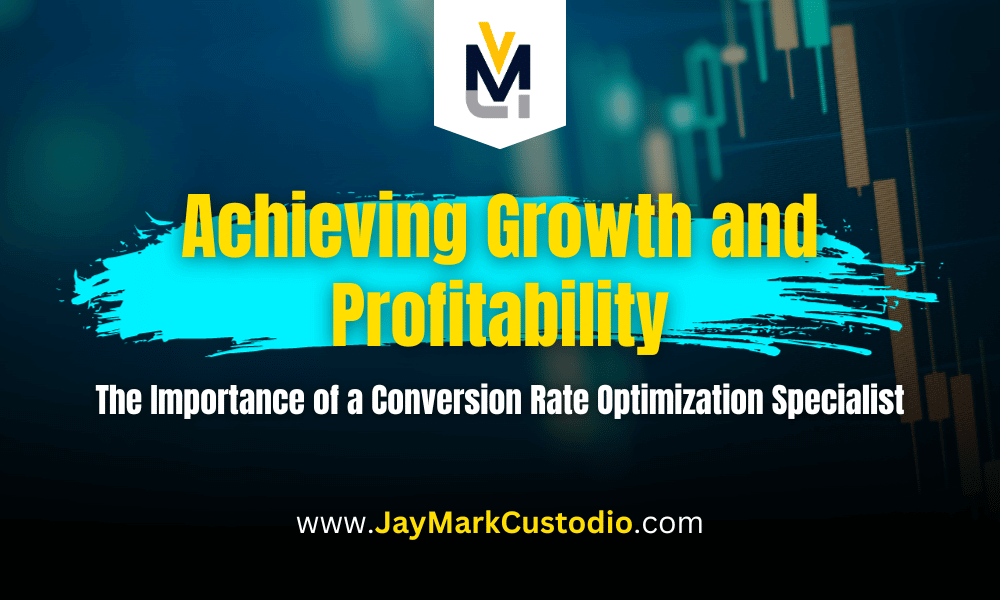In-Demand Skills
9 Steps to Mastering Conversion Rate Optimization and Becoming an Effective Specialist

Hey there, classmate!
Have you ever heard of a Conversion Rate Optimization Specialist?
If you’re interested in digital marketing, this could be a career path worth considering.
But is it the right choice for you? Suppose you decide to pursue this career.
How can you become an effective and successful Conversion Rate Optimization Specialist?
Measuring success can be tricky in this field, but specific metrics can give you a good idea of how well your campaigns perform.
Table of Contents
Speaking of campaigns, I’ve got some great tips and tricks for running a successful conversion rate optimization campaign.
But before we get into the nitty-gritty, let’s look at some successful case studies of conversion rate optimization efforts.
These real-life examples will better explain what it takes to make a difference in this field.
So, are you ready to learn more about becoming a Conversion Rate Optimization Specialist?
Let’s dive in and explore the nine steps that will help you succeed in this exciting career.
Is Becoming a Conversion Rate Optimization Specialist a Career That You Must Choose?
Whether or not you should pursue a career as a Conversion Rate Optimization (CRO) specialist depends on several factors, including your interests, skills, and career goals.
I enjoy working with data and am passionate about improving website performance. A CRO career can be an excellent choice.
CRO is a rapidly growing field, and businesses across industries are recognizing the value of optimizing their websites and marketing campaigns to increase conversions and revenue.
As a result, there is a high demand for skilled CRO specialists, making it a career with excellent job prospects.
To become a CRO specialist, you typically need technical and creative skills. These skills include data analysis, user experience design, copywriting, and A/B testing. (READ ALSO: 9 Reasons for Gen Z to Embrace Upgrading and Learning New Skills)
You may also benefit from knowledge of web development, SEO, and digital marketing tools and technologies.
As a CRO specialist, your role will involve analyzing website traffic, identifying areas for improvement, and developing and implementing strategies to
9 Steps to Become an Effective and Successful Conversion Rate Optimization Specialist
In today’s fast-paced digital world, businesses must stay ahead of the competition by optimizing their online presence.
The role of a conversion rate optimization specialist has become increasingly crucial in helping businesses achieve success in this area.
If you’re interested in pursuing a career in this field, you’ve come to the right place.
In this article, we’ll take nine steps to become an effective and successful conversion rate optimization specialist.
So, let’s dive in and explore what it takes to excel in this exciting field.
1. Gain a deep understanding of user behavior
Understanding user behavior is crucial for conversion rate optimization (CRO).
By studying how users interact with websites, you can identify areas for improvement and develop effective strategies to optimize conversions.
9 Steps to Gain a Deep Understanding of User Behavior
Here are nine steps to gain a deep understanding of user behavior.
1. Conduct thorough research: Research your target audience and understand their demographics, interests, and habits. Use tools like Google Analytics, surveys, and customer feedback to gather insights.
2. Analyze user data: Once you have gathered it, identify patterns and trends. Look for areas where users are dropping off or spending the most time.
3. Conduct user interviews: These can help you better understand user behavior. Ask questions about their pain points, motivations, and decision-making processes.
4. Use heatmaps: Heatmaps can help you visualize where users click and scroll on your website. It can give you insights into what content is most engaging to users.
5. Monitor user behavior in real-time: Use tools like session recordings and live chat to monitor user behavior. It can help you identify areas of confusion or frustration.
6. Conduct A/B testing: A/B testing can help you identify which design elements and messaging resonate best with your audience.
7. Use customer journey mapping: Customer journey mapping can help you identify the touchpoints where users will most likely convert or drop off.
8. Implement user feedback: This will improve the user experience and increase conversions. It can include changes to website design, messaging, or product offerings.
9. Continuously monitor and iterate: User behavior constantly evolves, so watching and repeating your CRO strategy is essential. Use data-driven insights to make informed decisions and test new ideas.
2. Learn the basics of web design and development
As a CRO specialist, you know the importance of optimizing websites for better conversions.
However, you must have a basic understanding of web design and development to carry out effective optimization strategies.
Knowing web design and development will help you understand how websites work and enable you to make informed decisions about design changes.
Effective communication with designers and developers will ensure the correct implementation of optimization strategies.
9 Steps to Learn the Basics of Web Design and Development in Detail
To help you get started, here are the nine steps to learn the basics of web design and development in detail.
1. Start with the basics of HTML and CSS: HTML and CSS are the building blocks of web design. By learning these two languages, you can create and style web pages.
2. Learn about website layout and design principles: Understanding website layout and design principles is essential to creating visually appealing and user-friendly websites.
3. Get familiar with responsive design: With more people accessing websites on mobile devices, it is essential to learn responsive design techniques. Responsive design ensures that websites display correctly on all devices, regardless of screen size.
4. Understand the importance of user experience (UX): User experience is critical to website design. By learning about UX, you can create websites that are easy to use and navigate.
5. Learn the basics of JavaScript and jQuery: JavaScript is a programming language that adds interactivity to web pages. jQuery is a JavaScript library that simplifies the process of writing JavaScript code.
6. Get to grips with website optimization techniques: Website optimization involves changing a website to improve performance. By learning optimization techniques, you can load websites faster and perform better.
7. Learn about web hosting and server-side programming concepts: Web hosting and server-side programming concepts are essential to understanding how websites work. By learning about these concepts, you can troubleshoot website issues and make informed decisions about hosting and server-side programming.
8. Get familiar with content management systems (CMS): Content management systems (CMS) are tools for efficiently creating and managing website content.
9. Keep learning and stay updated with the latest trends and technologies: Web design and development technologies constantly evolve. Stay updated with the latest trends and technologies to ensure that your websites are modern and practical.
By following these nine steps, you can develop a solid web design and development foundation, which will help you become a more effective CRO specialist.
3. Familiarize yourself with analytics tools
If you own a website, you already know how important it is to track visitor behavior and measure the success of your optimization efforts.
One of the best ways to achieve this is using analytics tools such as Google Analytics.
By learning how to use these tools, you can gain valuable insights into your website’s performance and identify areas for improvement.
9 Steps to Familiarize Yourself with the Process
To get started with analytics tools, here are nine steps you can take to familiarize yourself with the Process:
1. Sign up for an analytics tool: The first step is to choose an analytics tool and sign up for an account. Google Analytics is a popular choice and is free to use.
2. Install tracking code: Once you have signed up, you must install a tracking code on your website. It allows the analytics tool to collect data on your visitors’ behavior.
3. Set up conversion tracking: If you have specific goals for your website, such as making a sale or collecting email addresses, you can set up conversion tracking to measure how many visitors complete those goals.
4. Set up goal tracking: Similar to conversion tracking, you can also set up goal tracking to measure how many visitors complete specific actions on your website, such as filling out a contact form or watching a video.
5. Explore the tool’s interface: Once you have data coming in, take some time to explore the analytics tool’s interface and get familiar with the different reports and metrics available.
6. Set up custom dashboards: Most analytics tools allow you to create custom dashboards that show the metrics that are most important to you. Take some time to set up a dashboard that suits your needs.
7. Learn how to segment data: Segmentation enables breaking down website data into smaller, more specific groups, revealing patterns and trends.
8. Learn how to use reports: Reports are the bread and butter of analytics tools. Please familiarize yourself with the different reports available and learn how to interpret their data.
9. Experiment with different optimization strategies: Once you understand your website’s data, you can start experimenting with different optimization strategies and measuring their impact using your analytics tool.
These nine steps will help you become a more effective CRO specialist by familiarizing yourself with analytics tools.
4. Stay up to date with industry trends
Conversion Rate Optimization (CRO) is highly dynamic and constantly evolving.
It involves various techniques and technologies that help businesses improve their website’s performance and increase online revenue.
As a CRO professional, staying up to date with the latest trends and developments in the industry is essential.
9 Steps to Stay Up to Date with Industry Trends
This article will discuss the nine steps you can take to keep up with industry trends and stay ahead of the competition.
1. Attend Industry Conferences: Attending industry conferences is an excellent way to learn about CRO’s latest trends and technologies. You can meet other professionals in the field, exchange ideas, and learn from industry leaders.
2. Read Industry Blogs: Several blogs like this and websites dedicated to CRO provide valuable insights into industry trends and best practices. Make sure to follow them regularly and stay informed about the latest developments.
3. Join Online Communities: Online communities such as LinkedIn or Facebook groups are an excellent way to connect with other CRO professionals and learn from their experiences.
4. Network with Other Professionals: Networking with other professionals in the industry can help you stay informed about the latest trends and developments. Attend local meetups or industry events to meet other professionals and exchange ideas.
5. Subscribe to Newsletters: Many industry experts and companies offer newsletters that provide regular updates on industry trends and best practices. Subscribe to them to stay informed.
6. Follow Industry Experts on Social Media: Following industry experts on Twitter, LinkedIn, or other social media platforms can help you stay informed about the latest trends and developments.
7. Participate in Webinars: Webinars are an excellent way to learn about industry trends and best practices from your home or office.
8. Conduct Research: Conducting your own research can help you stay informed about CRO’s latest trends and developments. Look for case studies or research papers that provide insights into industry trends.
9. Experiment with New Techniques: Experimenting with new techniques and technologies can help you stay ahead of the competition. Stay curious and keep testing new ideas to improve your website’s performance.
Staying current with industry trends is crucial for any CRO professional who wants to succeed in the industry.
Following the nine steps outlined in this article, you can stay informed about the latest trends and developments in CRO and stay ahead of the competition.
Remember, the key to success in the industry is to stay curious, keep learning, and keep experimenting with new techniques and technologies.
5. Develop a testing mindset
Conversion Rate Optimization (CRO) is all about testing and experimentation.
To optimize conversion rates (CRO) effectively, one must adopt a testing mindset and be open to experimenting with various strategies.
It means setting up A/B tests, multivariate tests, and other experiments to identify the most effective optimization strategies.
9 Steps on How to Develop a Testing Mindset
This article will discuss the nine steps to develop a testing mindset to achieve better results in CRO.
1. Start with a hypothesis: Before starting any experiment, you must clearly understand what you want to achieve. Develop an idea outlining what you expect to happen when you change your website or landing page.
2. Define your goals: Clearly define the goals you want to achieve with your experiment. It will help you track your progress and measure the success of your optimization strategy.
3. Choose the right tools: To run successful experiments, you must have the right tools. Choose tools that are easy to use and provide accurate data.
4. Collect as much data as possible to inform your optimization strategy. Analyze user behavior, preferences, and feedback to identify improvement areas.
5. Set up experiments: Set up experiments that test your hypothesis and help you achieve your goals. Use A/B testing, multivariate testing, and other types of experiments to get accurate results.
6. Monitor progress: Monitor progress regularly to track the success of your experiments. Use data to make informed decisions about what changes to make to your optimization strategy.
7. Analyze results: Analyze the results of your experiments to identify trends and patterns. Use this information to refine your optimization strategy and make further improvements.
8. Iterate: Continuously iterate and refine your optimization strategy based on the results of your experiments. Keep testing and experimenting to achieve better results.
9. Learn: Always be willing to learn from your experiments. Use the insights gained from your experiments to improve your CRO skills and develop a more effective testing mindset.
Developing a testing mindset is crucial for achieving success in CRO.
Following the nine steps outlined in this article, you can develop a mindset focused on testing, experimentation, and continuous improvement.
Remember to always start with a hypothesis, define your goals, choose the right tools, collect data, set up experiments, monitor progress, analyze results, iterate, and learn.
By doing so, you can achieve better results and grow your business through effective conversion rate optimization strategies.
6. Hone your communication skills
As a CRO specialist, you will work with various stakeholders, including designers, developers, marketers, and business owners.
Effective communication is essential for any CRO specialist, as it allows you to explain complex ideas concisely, listen actively, and collaborate effectively.
9 Steps To hone your communication skills
To hone your communication skills, here are nine practical steps you can take:
1. Be clear and concise: Avoid jargon and technical language your audience may not understand. Use simple language and keep your message clear and concise.
2. Listen actively: Pay attention to what others are saying, and show that you are listening by asking questions and clarifying information.
3. Be mindful of your body language: Your body language can convey a lot about how you are feeling and what you are thinking. Ensure eye contact, avoid crossing your arms, and use appropriate facial expressions.
4. Practice empathy: Try to understand your audience’s perspective and empathize with their concerns and challenges.
5. Use visual aids: Charts, diagrams, and other visual aids can help convey complex ideas more effectively and make your message more engaging.
6. Build rapport: Connect with your audience by finding common ground and creating a friendly and collaborative atmosphere.
7. Be confident: Speak confidently and confidently, and avoid using filler words like “um” and “ah.”
8. Practice, practice, practice: The more you practice your communication skills, the more confident and effective you will become.
9. Seek feedback: Ask for feedback from your audience and colleagues to help you identify areas for improvement and refine your communication skills. (READ ALSO: 9 Reasons for Gen Z to Embrace Upgrading and Learning New Skills)
In conclusion, effective communication is a critical skill for any CRO specialist.
Following these nine steps, you can hone your communication skills and become more effective and influential.
7. Be data-driven
CRO (Conversion Rate Optimization) is a field that heavily relies on data-driven decisions.
To excel in this field, one must have a firm grasp of data analysis and an ability to draw insights from it.
9 Steps to Be Data-Driven
1. Define Your Objectives: To be data-driven, it is essential first to define your objectives so that you can measure and analyze your progress towards achieving them.
2. Collect Data: Collect relevant data that aligns with your objectives. It might include website traffic data, sales data, or customer feedback.
3. Clean Your Data: Ensure your data is clean and free of any errors or inaccuracies that could skew your analysis.
4. Analyze Your Data: Use analytical tools like Excel or statistical software to analyze your data and identify patterns or trends.
5. Visualize Your Data: Create visualizations like charts or graphs to help you better understand and communicate your findings.
6. Draw Insights: Use your data analysis to draw insights and conclusions to inform your decision-making.
7. Test Your Hypotheses: Test your hypotheses by running experiments to validate your insights.
8. Implement Your Findings: Use your insights to inform your decisions and implement changes that drive results.
9. Continuously Monitor and Refine: Monitor your data and refine your approach based on new insights or changes in your objectives.
Being data-driven is essential for success in CRO.
By following these nine steps, you can ensure that your decisions are informed by data and aligned with your objectives.
By collecting, analyzing, and drawing insights from data, you can make informed decisions that drive results and improve your overall performance.
8. Focus on the customer
A successful CRO specialist is customer-focused and puts the customer’s needs first.
You should empathize with your customers and understand what motivates them.
It means conducting user research, analyzing customer feedback, and developing optimization strategies prioritizing customer experience.
This article will discuss nine steps to help you focus on the customer and improve your CRO strategies.
9 Steps to Focus on the Customer
1. Define your target audience: The first step towards focusing on the customer is to define your target audience. You need to know who your customers are, their needs, and how you can meet them.
2. User research: User research is crucial to understanding your customers. You can use various methods, such as surveys, interviews, and usability testing, to gather feedback and insights.
3. Analyze customer feedback: Feedback from customers can help you understand their needs and preferences. Analyze feedback from various channels such as social media, customer support, and reviews.
4. Develop customer personas: Customer personas are fictional representations of ideal customers. Developing personas can help you understand your customers better and create personalized experiences for them.
5. Map the customer journey: Mapping the customer journey can help you identify pain points and opportunities for improvement. You can use journey maps to optimize the customer experience at every touchpoint.
6. Optimize website usability: Website usability is crucial to the customer experience. Optimize your website by improving navigation, reducing load times, and simplifying checkout.
7. Personalize the experience: Personalizing the customer experience can help you create a more engaging and relevant experience for your customers. Use data to create personalized recommendations, promotions, and content.
8. Test and iterate: Testing and iteration are crucial to CRO. Test different variations of your website and marketing campaigns to see what works best for your customers.
9. Measure success: Measuring success is essential to understanding the impact of your CRO strategies. Use metrics such as conversion, bounce, and engagement rates to track progress and make data-driven decisions.
Focusing on the customer is crucial to CRO’s success.
By understanding your customers’ needs, you can create personalized experiences that drive conversions and improve customer satisfaction.
Use the nine steps above to focus on the customer and improve your CRO strategies.
A successful CRO specialist is customer-focused and puts the customer’s needs first.
You should empathize with your customers and understand what motivates them.
It means conducting user research, analyzing customer feedback, and developing optimization strategies prioritizing customer experience.
9. Be adaptable and flexible
The world of CRO (Conversion Rate Optimization) is dynamic and ever-evolving.
To succeed in this field, you need to be adaptable and flexible, willing to change your approach to achieve the best results.
It means being open to new ideas and approaches, learning from your mistakes, and pivoting quickly when necessary.
9 Steps for you be adaptable and flexible in your approach
Here are nine steps that can help you be adaptable and flexible in your approach to CRO:
1. Stay up-to-date with the latest trends and best practices in the industry.
2. Be open to feedback and suggestions from your team members and clients.
3. Continuously test and experiment with new ideas and approaches.
4. Be willing to take calculated risks and try new things.
5. Learn from your failures and mistakes and use them as an opportunity for growth and improvement.
6. Identify potential issues or roadblocks and develop solutions to overcome them.
7. Foster a culture of collaboration and teamwork and encourage open communication between team members.
8. Be willing to adjust your strategy based on changing circumstances or new information.
9. Stay focused on your goals, but be flexible in achieving them.
In conclusion, being adaptable and flexible is crucial for success in CRO.
With these nine steps, you can cultivate a growth-oriented mindset that can pivot quickly for optimal outcomes.
How do you measure success as a Conversion Rate Optimization Specialist?
As a Conversion Rate Optimization (CRO) Specialist, success is measured by the impact of your work on website conversion rates and business goals.
Here are a few metrics that are commonly used to measure the success of CRO efforts:
1. Conversion Rate: This is the most basic metric for measuring CRO success. It measures the percentage of website visitors who take a desired action, such as purchasing or filling out a form.
2. Revenue: Ultimately, the goal of CRO is to drive more revenue for a business.
CRO specialists can help businesses increase their revenue and profitability by improving conversion rates.
3. Return on Investment (ROI): CRO requires time and resources, so measuring your efforts’ ROI is essential.
This can be calculated by comparing the cost of your CRO efforts to the revenue generated from those efforts.
4. Average Order Value (AOV): measures the average value of each order. AOV is essential for e-commerce businesses, as it helps measure marketing campaigns and website optimization.
Upselling and cross-selling can increase AOV. CRO specialists optimize product pages, improve product recommendations, and implement upselling and cross-selling to increase AOV and revenue.
Case Studies for Successful Conversion Rate Optimization
Many case studies demonstrate the success of Conversion Rate Optimization (CRO) in improving website performance and driving revenue for businesses.
Here are a few examples:
1. Moz: Moz, a software company that provides SEO and digital marketing tools, used CRO to increase their free trial signups by 52%. They achieved this by simplifying their signup process and making it more intuitive for users.
2. Crazy Egg: Crazy Egg, a website analytics company, used CRO to increase its revenue by 21%. They achieved this by optimizing their pricing page, using persuasive messaging and social proof to encourage conversions.
3. HubSpot: HubSpot, a marketing software company, used CRO to increase their lead generation by 24%. They achieved this by optimizing their landing pages and using A/B testing to test different approaches.
4. VWO: VWO, a website optimization company, used CRO to increase its revenue by 90%. They achieved this by optimizing their pricing page and using persuasive messaging to encourage conversions.
5. Hootsuite: Hootsuite, a social media management company, used CRO to increase their free trial signups by 32%. They achieved this by optimizing their signup process and using persuasive messaging to encourage signups.
These case studies demonstrate the power of CRO in improving website performance and driving revenue for businesses.
Businesses can increase conversions and achieve goals by optimizing website design, messaging, and user experience.
9 Tips and Tricks for a Successful Conversion Rate Optimization Campaign
If you’re working on a Conversion Rate Optimization (CRO) campaign, here are nine tips and tricks to help ensure its success:
1. Identify your goals: Before you start your campaign, identify your goals and what you want to achieve. This will help you focus your efforts and measure success.
2. Understand your audience: To optimize for conversions, you need to understand your audience and what motivates them to take action. Use data and analytics tools to gain insights into your audience’s behavior and preferences.
3. Focus on user experience: User experience is critical in conversion rates. Ensure your website is easy to navigate, loads quickly, and optimized for mobile devices.
4. Test and experiment: Use A/B testing and other experimentation techniques to test different variations of website elements, such as headlines, images, and calls to action. This will help you identify the most effective approaches.
5. Optimize your forms: Forms are a common friction point in the conversion process. Optimize your forms to make them as easy and intuitive as possible.
6. Use social proof: Social proof, such as customer reviews and testimonials, can be a powerful motivator for conversions. Make sure to display social proof on your website prominently.
7. Offer incentives: Offering incentives, such as discounts or free trials, can effectively encourage conversions.
8. Use retargeting: Retargeting is a tactic that involves showing ads to people who have previously visited your website. This can be an effective way to bring people back to your website and encourage conversions.
9. Monitor and analyze results: Finally, make sure to monitor and analyze the results of your CRO campaign. Use data and analytics tools to measure the impact of your efforts and identify areas for further optimization.
By following these tips and tricks, you can create a successful CRO campaign that drives more conversions and revenue for your business.
Conclusion
So, classmate, As we wrap up our discussion on Conversion Rate Optimization (CRO) Specialist, it’s essential to consider whether this is a career path you must choose.
While there is no one-size-fits-all answer to this question, it’s clear that CRO is a critical aspect of any business’s success in today’s digital age.
As a CRO Specialist, you’ll be responsible for improving website performance, increasing conversions, and ultimately driving revenue growth for your company.
To become an effective and successful CRO Specialist, consider nine critical steps.
These include understanding your audience, setting clear goals, conducting thorough research, designing practical tests, analyzing data, and more.
By following these steps, you’ll be well on your way to becoming a top-performing CRO Specialist.
These include conversion rate, bounce rate, time on page, and more.
By monitoring these metrics closely, you’ll be able to identify areas for improvement and make data-driven decisions that drive results.
Case studies are an excellent way to learn from successful CRO campaigns and apply these learnings to your work.
You can identify best practices and avoid common pitfalls by studying successful campaigns.
Finally, several tips and tricks can help you run a successful CRO campaign.
These include focusing on high-impact changes, setting realistic goals, gathering qualitative feedback, and more.
In conclusion, becoming a Conversion Rate Optimization Specialist can be a rewarding career choice for those interested in digital marketing and website optimization.
By following the nine steps outlined above, measuring success through critical metrics, and studying successful case studies, you’ll be well-equipped to run successful CRO campaigns and drive revenue growth for your company.
Best of luck on your journey to becoming a successful CRO Specialist!
References
- FAQ Page – Frequently Asked Questions – Marketing. https://digitalcue.io/faq-page/
- SEO + PPC – Conroy Creative Counsel | Best Law Firm Websites. https://conroycreativecounsel.com/category/seo/
- Embodied Carbon and Whole Life Carbon Assessment | Stroma. https://stroma.com/built-environment-consultants/built-environment-services/energy-performance/carbon-assessments/
- Marketing Geeks’ Gratitude | Substance151. https://substance151.com/marketing-geek-gratitude/
- HTML/CSS – MigraCode Barcelona Student Guide. https://syllabus.migracode.org/courses/introduction-3/course-content/html-css
- Must Have Front End Developer Skills to Get Hired – Smartupworld. https://smartupworld.com/blogs/must-have-front-end-developer-skills-to-get-hired/
- Owusu-Afriyie, Philip. “Capstone Management System.” 2020, https://core.ac.uk/download/389367591.pdf.
- jQuery Archives – Satyadarshin. https://www.satyadarshin.com/project-tag/jquery/
- HOW TO START A RESEARCH PROPOSAL EXAMPLE. https://9papers.space/38430/how-to-start-a-research-proposal-example/
- The Power of Testing and Optimization: CRO Tools and Best Practices. https://digitalmarketingsupermarket.com/blog/cro-tools-and-best-practices/
- Streamline Your SEO Efforts with Search Engine Position Tracking. https://blog.serpscan.com/search-engine-position-tracking
- Guide to starting a blog – Commence.page. https://blog.commence.page/posts/guide-in-14-points-to-starting-a-blog
- No Risk Poker Guide – The Poker Guide. https://www.the-poker-guide.com/5-tips-for-no-risk-poker-freerolls-explained.html
- 9 Ways to Overcome Fear of Investing and Start Making Money. https://www.wealth-ideas.com/9-ways-to-overcome-fear-of-investing-and-start-making-money/
- How do I use AdWords for SEM – szirmai programming solutions. http://szirmai.com/how-do-i-use-adwords-for-sem.html
- Cbs News Make Money Online | What You Need to Know About Making Money Online With CBS News. https://business380.com/cbs-news-make-money-online/
- The Art of Conversation: Mastering Small Talk for Networking Success | Business Allies. https://vaallies.org/the-art-of-conversation-mastering-small-talk-for-networking-success/
- Unlock Your Inner Confidence: Learn the Secrets of Public Speaking and Become an Effective Speaker – Hocken Heimring Shop. https://hockenheimring-shop.com/unlock-your-inner-confidence-learn-the-secrets-of-public-speaking-and-become-an-effective-speaker/
- Digital Women’s Leadership Program – Module 2 – itag. https://itag.ie/events/digital-womens-executive-leadership-program-day-2-2/
- How to Run a CBD Business – Weeds Leaf. https://weedsleaf.com/how-to-run-a-cbd-business/
- building key personas Content – HeartBrain Marketing. https://heartbrain.marketing/tag/building-key-personas/
- Growth Hacking Tactics: 11 Ways To Hack Growth In 2023! – Prime One Community. https://engage.primeone.global/question/growth-hacking-tactics-11-ways-to-hack-growth-in-2023/
- What is Real Time Marketing And How Does It Help Marketers Achieve Their Goals? – Aekot. https://blog.aekot.com/what-is-real-time-marketing-and-how-does-it-help-marketers-achieve-their-goals/
- How to Maximize Your Website’s Conversion Rate – Swydo. https://www.swydo.com/blog/maximize-your-website-conversion-rate/
- Online Marketing Agency: How to Choose the Right One for Your Business | Locally. https://www.locally.net.au/post/online-marketing-agency-how-to-choose-the-right-one-for-your-business
- Simple Steps to Boost Your Website: Digital Marketing Tips. https://theocdigitalmarketing.com/simple-steps-to-boost-your-website-digital-marketing-tips-for-beginners/
- Seven ways to increase online sales. https://www.nexuswatchers.com/news/seven-ways-to-increase-online-sales
- Advertising Tips For Real Estate Agents – Realty Marketing Tools. https://realtymarketingtool.com/advertising-tips-for-real-estate-agents/
- Facebook Ads | JINN.ee. https://jinn.ee/facebook-ads/
- How to Create a Successful Communications Plan – Harf. https://www.harfpromo.com/how-to-create-a-successful-communications-plan/





















